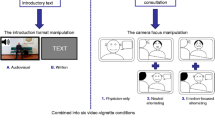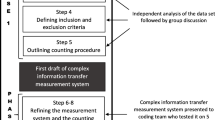Abstract
Most medical interaction studies have been conducted on audiotaped recordings of physician-patient encounters. Empirical studies have not previously demonstrated whether coders' scores differ on audio-only versus videotaped data. Data from a convenience sample of forty-seven physician-patient interactions were analyzed using the same coding systems to judge audio-only versus video-based data formats. All coding conditions demonstrated acceptable reliability, using intraclass correlation coefficients. However, MANOVA analyses show that ratings of audiotaped physician-patient interactions are not equivalent to ratings of videotaped encounters. Exploratory factor analyses show differences in the underlying structures of the data derived from the audio-only versus the video information. The differences in the video-based factor solutions account for more total variance and are more consistent with theoretical expectations.
Similar content being viewed by others
References
Albrecht, T.L., & Adelman, M.B. (1984). Social support and life stress: New directions for communication research. Human Communication Research, 11, 3-32.
Albrecht, T.L., Adelman, M.B., and Associates (1987). Communicating social support. Newbury Park, CA: Sage.
Albrecht, T.L., Blanchard, C.G., Ruckdeschel, J.C., Coovert, M., & Strongbow, R. (1999). Strategic physician communication and oncology clinical trials. Journal of Clinical Oncology, 17, 3324-3332.
Albrecht, T.L., & Goldsmith, D.J. (in press). Social support, social networks, and health. Forthcoming in T. Thompson et al. (Eds.), Handbook of health communication. Hillsdale, NJ: Erlbaum.
Bartko, J.J. (1979). Various intraclass correlation reliability coefficients. Psychological Bulletin, 83, 762-765.
Bartko, J.J., & Carpenter, W.T. (1976). Methods and theory of reliability. Journal of Nervous Mental Disorders, 163, 307-317.
Bavelas, J. B. (1994). Gestures as part of speech: Methodological implications. Research on Language and Social Interaction, 27, 201-221.
Bavelas, J. B., & Chovil, N. (2000). Visual acts of meaning: An integrated message model of language in face-to-face dialogue. Journal of Language and Social Psychology, 19, 163-194.
Bavelas, J. B., Chovil, N., Coates, L., & Roe, L. (1995). Gestures specialized for dialogue. Personality and Social Psychology Bulletin, 21, 394-405.
Bédard, M., Martin, N., Krueger, P., & Brazil, K. (2000). Assessing reproducibility of data obtained with instruments based on continuous measurements. Experimental Aging Research, 26, 353-365.
Blanchard, C.G., Labrecque, M. S., Ruckdeschel, J. C., & Blanchard, E.G. (1988). Information and decision-making preferences of hospitalized adult cancer patients. Social Science and Medicine, 27, 1139-45.
Burgoon, J. (1994). Nonverbal signals. In M.N. Knapp, & G. R. Miller (Eds.), Handbook of interpersonal communication, 2nd Ed. (pp. 229-285). Thousand Oaks, CA: Sage.
Caris-Verhallen, W.M.C.M., Kerkstra, A., & Bensing, J. M. (1999). Non-verbal behaviour in nurse-elderly patient communication. Journal of Advanced Nursing, 29, 808-818.
Crippa, J. A., Sanches, R. F., Hallak, J. E., Loureiro, S. R., & Zuardi, A. W. (2001). A structured interview guide increases Brief Psychiatric Rating Scale reliability in raters with low clinical experience. Acta Psychiatrica Scandanavia, 103, 465-470.
Daly-Jones, O. (1998). Some advantages of video conferencing over high-quality audio conferencing: Fluency and awareness of attentional focus. International Journal of Human-Computer Studies, 49, 21-58.
DiMatteo, M. R., Taranta, A., Friedman, H. S., & Prince, L. M. (1980). Predicting patient satisfaction from physicians' nonverbal communication skills. Medical Care, 18, 376-387.
Fabrigar, L. R., Wegender, D. T., MacCallum, R. C., & Strahan, E. J. (1999). Evaluating the use of exploratory factor analysis in psychological research. Psychological Methods, 4, 272-299.
Ford, S., Fallowfield, L., & Lewis, S. (1996). Doctor-patient interactions in oncology. Social Science and Medicine, 42, 1511-1519.
Ford, S., Hall, A., Ratcliffe, D., & Fallowfield, L. (2000). The Medical Interaction Process System (MIPS): An instrument for analyzing interviews of oncologists and patients with cancer. Social Science and Medicine, 50, 553-66.
Fransson, P., Tavelin, B., & Widmark, A. (2001). Reliability and responsiveness of a prostate cancer questionnaire for radiotherapy-induced side effects. Supportive Cancer Care, 9, 187-98.
Friedman, H. S. (1979a). Nonverbal communication between patients and medical practitioners. Journal of Social Issues, 35, 82-99.
Friedman, H. S. (1979b). The interactive effects of facial expressions of emotion and verbal messages on perceptions of affective meaning. Journal of Experimental Social Psychology, 15, 453-469.
Gillotti, C., Thompson, T., & McNeilis, K. (2002). Communicative competence in the delivery of bad news. Social Science and Medicine, 54, 1011-1023.
Greene M.G., Adelman R.D., Friedmann E., & Charon R. (1994). Older patient satisfaction with communication during an initial medical encounter. Social Science and Medicine, 38, 1279-88.
Griffin, J. (1998). How to say it at work: putting yourself across with power words, phrases, body language, and communication secrets. Paramus, NJ: Prentice Hall.
Ickes, W. (1994). Methods of studying close relationships. In A. Weber, & J. Harvey, Eds., Perspectives on close relationships (pp. 18-44). Boston, MA: Allyn & Bacon.
Ickes, W., & Tooke, W. (1988). The observational method: Studying the interaction of minds and bodies. In S. Duck, & S. Hay (Eds.), Handbook of personal relationships: Theory, research, and interventions (pp. 79-97). Chichester, England: John Wiley.
Larsen, K. M., & Smith, C. K. (1984). Sequential nonverbal behavior in the patient-physician interview. Journal of Family Practice, 18, 257-261.
MacCallum, R. C., Widaman, K. F., Zhang, S. B., & Hong, S. H. (1999). Sample size in factor analysis. Psychological Methods, 4, 84-99.
Macnab, A. J., Levine, M., Glick, N., Phillips, N., Susak, L., & Elliott, M. (1994). The Vancouver sedative recovery scale for children-validation and reliability of scoring based on videotaped instruction. Canadian Journal Anesthesiology, 41, 913-918.
Mechanic, D., & Meyer, S. (2000). Concepts of trust among patients with serious illness. Social Science and Medicine, 51, 657-668.
Mortensen, C. D. (1997). Miscommunication. Thousand Oaks, CA: Sage.
Nichol, J. D., & Watson K. E. (2000). Videotutoring, non-verbal communication and initial teacher training. British Journal of Educational Technology, 31, 135-144.
Ong, L. M. L., Visser, M. R. M., Kruyver, I.P.M., Bensing, J.M., van den Brink-Muinen, A., Stouthard, J.M.L., Lammes, F.B., & de Haes, J.C.J.M. (1998). The Roter Interaction Analysis System (RIAS) in oncological consultations: Psychometric properties. Psycho-Oncology, 7, 387-401.
Rosser, W. W., & Kasperski, J. (2001). The benefits of a trusting physician-patient relationship. The Journal of Family Practice, 50, 329-330.
Roter, D.L. (1991). The Roter Method of Interaction Process Analysis: RIAS Manual. Baltimore, MD: Johns Hopkins University.
Roter D. L., Geller, G., Bernhardt, B. A., Larson, S.M., & Doksum T. (1999). Effects of obstetrician gender on communication and patient satisfaction. Obstetrics and Gynecology, 93, 635-641.
Roter, D.L., Larson, S., Fischer, G. S., Arnold, R. M., & Tulsky, J. A. (2000). Experts practice what they preach-A descriptive study of best and normative practices in end-of-life discussions. Archives of Internal Medicine, 160, 3477-3485.
Rummell, R.J. (1970). Applied factor analysis. Evanston, IL: Northwestern University Press.
Ruusuvuori, J. (2001). Looking means listening: Coordinating displays of engagement in doctor patient interaction. Social Science and Medicine, 52, 1093-1108.
Saw, S.M., & Ng, T.P. (2001). The design and assessment of questionnaires in clinical research. Singapore Medical Journal, 42,131-5.
Shrout, P. E., & Fleiss, J. L. (1979). Intraclass correlations: Uses in assessing rater reliability. Psychological Bulletin, 86, 420-428.
Streiner, D.L. (1995). Learning how to differ: Agreement and reliability statistics in psychiatry. Canadian Journal of Psychiatry, 40, 60-66.
Streiner, D.L, & Norman, G.R. (1995). Health measurement scales (2nd ed). New York: Oxford University Press.
Watzlawick, P., Beavin, J., & Jackson, D. (1967). Pragmatics of human communication. New York: Norton.
Author information
Authors and Affiliations
Rights and permissions
About this article
Cite this article
Riddle, D.L., Albrecht, T.L., Coovert, M.D. et al. Differences in Audiotaped Versus Videotaped Physician-Patient Interactions. Journal of Nonverbal Behavior 26, 219–239 (2002). https://doi.org/10.1023/A:1022160117278
Issue Date:
DOI: https://doi.org/10.1023/A:1022160117278




